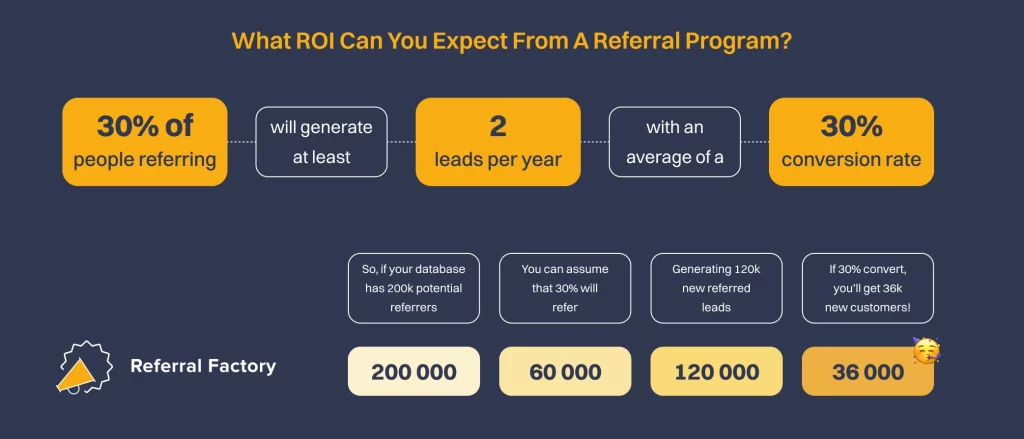Develop a Referral Marketing Strategy in 7 Steps [Free Slides To Download]
If you’re thinking of launching a refer a friend program but don’t know where to start, you need to put together a referral marketing strategy. Not only will it help you figure out how to begin, but it will also help you optimize as your referral program gets off the ground. In this guide, we’ll show you how to put together a referral marketing strategy that’ll impress your team in 7 simple steps. We walk you through how to budget for a referral program, how to set targets and forecast your ROI, the best referral rewards to motivate your referrers, and how to set up referral tracking.
Plus! To simplify the creation of your referral marketing strategy, download our free customizable slides. Just insert your business details, and voilà – you are ready to pitch your new referral strategy to your manager or present it to your team!
Table of Contents
Why Is Referral Marketing Effective?
Try to remember the last time you were told about a cool product or service and immediately believed what you heard. Was it an ad? It could be. Yet, in most cases, people don’t believe adverts that much. In terms of credibility, they don’t get even close to recommendations from friends, family, or buddies from work. It’s simple: you trust the people you know and their experiences.
And that’s the biggest secret of a referral marketing strategy. It is based on personal connections and TRUST. Think of a cold sales call and a recommendation from your friend. Those two produce polar emotions. Even though, in both cases, you learn about the product/service for the first time, a sales call is annoying, while a friend’s recommendation is helpful and reliable.
That’s why referral marketing always seems much more native than most of the other marketing strategies. Besides, referral programs are highly flexible and adjustable to almost any business. Let’s take a glance at some of the major benefits every brand can get:

Step-by-Step Referral Marketing Strategy Creation
When satisfied clients sing your praises, they attract new audiences and build trust for your brand. Seems logical, right? But hoping that this will happen organically is probably the wrong tactic. No matter how good your product is, without a strategically designed referral marketing program, customers will mention you to their friends occasionally at most.
#1 Establish Your Baseline Customer Acquisition Costs
What’s the first step of creating your referral marketing strategy? Figure out how much it costs for your business to get a new customer.

By knowing these metrics, you’ll set the right goals for your referral program. You will also be able to decide on the budget you can allocate to reward people for bringing in new customers. This is one of the essentials you have to determine before starting the referral campaign or even pitching the whole idea to your top management.
#2 Establish a Referral Funnel
Your next step will be to figure out who will participate in your referral programs. You have quite a few options:
- Current customers
- Unconverted leads
- Employees
- Partners
- Influencers
- Affiliates
The best part is that you can choose multiple groups of advocates and create a separate funnel based on the types of referrals. Won’t it be too much of a hassle? It could be, but if you have the right software, your referral program management will be a no-brainer.
With Referral Factory, you can set multiple referral campaigns with different incentives, requirements, terms, etc. What about rewards? You can track them individually in a single dashboard, eliminating the stress and the need for synchronization.
#3 Determine What Constitutes a Successful (aka Converted) Referral
Good news: you can forget about crossing your fingers and wondering if a lead will ever turn into a customer. One of the best things about a referral marketing strategy, apart from the qualified lead generation, is its pay-per-performance approach. Unlike with some other methods, you only reward your person referring (those who recommend your brand to others) when the person invited (i.e., their friend) converts.
That’s why referral marketing always brings you clients who are truly interested in your offer. Still, first, you have to define what a conversion (aka the successful referral) for your referral marketing program is. These metrics can be different:
- Spending a certain amount with you
- Completing an X amount of orders
- Inviting X number of people
- Completing a demo
- Subscribing to your services
- Staying with you for X time
- etc.
Besides, remember that you can use a combination of requirements. Still, the most important thing to keep in mind is BALANCE. Of course, you want to keep your conversions beneficial for your business. But the requirements have to be doable and not too complicated for your referral program participants. The key is to know your goals and keep your clients in mind. That’s the best way to customize your campaign and make it effective.
#4 Calculate Your Potential ROI & Set Referral Program Targets
Here’s a quick review of what you can expect from a referral program based on the Referral Factory data:

That’s a general picture, of course. Your program might attract even more customers; maybe each of your existing clients will bring in 3 or more leads, or your conversion rate could soar to 40%.
No matter what, you have to do your calculations. Here are the basic metrics you have to keep in mind:
- How many customers do you have?
- What percentage might join your referral program?
- How many leads can each person referring bring in?
- What ROI do you expect?
You can also use our free referral calculator to check how many referrals your campaign can generate. Once you calculate your expected ROI, you can adjust your strategy accordingly.
#5 Choose Your Referral Rewards
A referral reward is a type of incentive businesses offer their existing customers for referring new people. The idea is the following: if you reward your customers for spreading the word about your brand, you’ll drive both sales and engagement.
Let’s take a look at the rewards you can give:
🎁 Cash. Cash is one of the most successful referral rewards ever. It’s attractive because it is tangible and can be used for a referral campaign of any size. Cash rewards are easy to automate, which makes it simpler to refer people.
🎁 Gift cards. Gift cards are a compelling and practical solution for referral rewards. There are many advantages for the business itself. For instance, compared to personalized rewards or experiences, gift cards can often be offered at a competitive price point, maximizing the ROI of your referral program. Besides, the selection of retailers and merchants is vast. So, gift cards cater to a variety of tastes and preferences. As you understand, it helps you target a bigger audience and increase the chances of reward satisfaction among both the person referring and the person invited.
🎁 Free products. This is the cherry on the cake. Literally, everybody likes free stuff. By giving customers something unique without them having to pay for it, you create a positive experience they won’t forget. In the end, happy customers become loyal fans. They trust you, stick with you, and spread the word about you.
🎁 Discounts. People really like getting discounts. When companies give special offers, they attract new customers and make the existing ones excited to tell their friends about the brand. As a result, businesses sell more and make clients feel connected and loyal. This is also one of the most common ways of getting an immediate engagement.
🎁 Charity donations. Your social responsibility commitment can be a great addition to your referral programs. Usually, what businesses do is offer their customers to donate their referral bonus. It can be a predetermined cause or the charity your clients choose. Charitable donations work especially well for NGOs, solar, and other sustainability-related niches. You’d be surprised how many people will love this philanthropic element of your campaign. As a bonus, all the donations you make in the name of your referral program participants are tax-deductible.
Apart from the reward type, you have to consider different reward structures. Let’s see some of the most popular options:
- Double-sided vs. single-sided campaigns. A double-sided program is a win-win when both a person referring and a person invited get a reward. A single-sided means that only one of them will get rewarded. Of course, incentivizing both parties proves to be a more effective option.
- Tiered rewards. In a referral program with tiered rewards, customers get different prizes based on how many friends they refer. The more friends they bring in, the better the rewards. For example, for 1 person converted, you get $5, whereas for 3 people – $20, and $35 for 5 people.
- Commission-based rewards. That’s exactly what it sounds like. With such campaigns, your person referring will get a commission for every person invited and converted. Usually, it would be a fixed percentage of the amount spent by their friends.
Before you start, make sure you’ve checked what your competitors offer to their customers. This approach will help you in many ways: you’ll get to know typical referral rewards in your niche and decide what to do to stand out.
#6 Choose a Referral Tracking Mechanism
Tracking your referral program’s success is key to making it shine. After all, you need to make sure you know who referred who so you can get those referral rewards off to the right people. There are different ways to do this. Let’s check what you have at your disposal:
- Referral links. This is one of the newest tracking mechanisms in referral marketing that’s proved to be highly efficient. Links are easy to generate and track. Plus, you can add a personal touch to the messages you share. The best part is that you don’t need to do anything yourself if you get proper referral marketing software. Think of it as your all-in-one referral tracking assistant. It automatically monitors clicks, conversions, and rewards. This is definitely the best way to get clear insights into what’s working and what’s not. Often, you can also find some extra perks. For example, Referral Factory allows you to build personalized landing pages. This means you can tweak your referral program without having to rely on a usually busy development team. That’s what you call a plug-and-play solution built by marketers for marketers.
Want to generate referral links? Try Referral Factory’s free referral link generator, which uses AI to automatically generate links with your business’s branding using your website url. Try it out >>
- Referral cards. It’s a traditional, even a classic, way to place a referral message on physical cards that companies give customers to share with friends, colleagues, or family. Yet, this approach is only effective for small business referral programs because as soon as you have over 50 clients, campaign tracking will get too complicated.
- Referral codes. It’s another method used in referral campaigns. The idea is that people share their unique codes with their friends to get rewarded once they use them. Yet, this approach is not suitable for all types of businesses. Why? Referral codes require a digital checkout of some kind, so are best suited to eCommerce and won’t work well for businesses with longer sales cycles. Besides, they mean that the person referring needs to do quite a lot of work to get their friend to the finish line: there is no personalized offer and no instructions. If you’re still wondering if referral codes are right for your business, watch this video on how referral codes work.
#7 Decide on How to Get People to Participate in Your Referral Program
Now that you’ve built your program, it’s time to activate it and invite people to join! But how do you get them to share links and invite others? The answer is … promotion. This is a super important part of your referral marketing strategy! Yet, before we get into that, let’s see the technical side of the question. How do people join? There are two main options:
Option 1: Opt-in & Sign-up
This is the cautious approach when your potential person referring actively chooses to join the program by signing up and accepting your terms and conditions. This way, everything is clear. You’ve got their explicit consent to send them program updates and track their referrals.
👍 Pros:
- Compliance: Clear consent minimizes legal risks, especially if you are bound by GDPR or similar data privacy laws
- Engaged persons referring: Opt-in suggests higher motivation and participation.
- Targeted communication: You tailor messages to the specific person referring.
👎 Cons:
- Slower launch: It takes time to get people signed up.
- Potentially lower participation: the approach requires extra effort from a person referring.
Option 2: Auto-Generated Links
This option accelerates the process slightly by creating referral links for your existing users. It’s easier and requires no additional effort from your customers, which boosts participation. Just think carefully about how you deliver these links.
👍 Pros:
- Faster rollout: You get quick and easy onboarding for a wider reach.
- Potentially higher participation: Lower entry barrier can increase the number of referrals.
- Targeted links: You can still personalize links based on user data.
👎 Cons:
- Compliance considerations: You must ensure proper communication and opt-out options.
- Potential user annoyance: Sending unsolicited links can backfire.
What else can you do to promote your referral program? Use a 360-degree approach when you engage all possible channels of promotion and communication. Of course, you can start with social media. But try to complement it with physical assets. Make sure to advertise your referral program in every physical location that matters. Create QR codes that people can scan and spread through your offices and the partner locations. And, consider using a newsletter or setting up an affiliate program.
But that’s not all. You can also use the following tactics:
- Get your employees to mention the referral program. Your employees spend all day talking to customers, business networks, and other people engaged. Aren’t they in the perfect position and moment to promote your referral program? You can even encourage your team to add the referral program to their email signature.
- Mention the referral program in your blogs. Check which pages bring you the most traffic. The next step is easy: just add your referral links (whether in a banner or a pop-up) and see what happens next.
- Find influencers to participate in your program. Influencers and referral programs are a match made in digital heaven. First of all, they can advertise your program, showing people that they can trust your brand. If followers trust them, they trust everything they share.
- Engage your sales and support team. When you ask customers for feedback, take the opportunity to ask them to casually refer your brand to others. This works well, especially if you receive positive online reviews. Train your sales and support teams to actively share the details about your referral programs with clients. It might take more effort, but the results can surprise you!
Want even more ideas? Check our guide on how to get referrals.
Referral Marketing Strategy 101: Tried-and-True Practices
To make your referral program even more effective, we recommend looking at (and actually applying!) the following best practices:
- Make it easy to understand. The biggest enemy of marketing is complex, unclear language. If people have a hard time understanding your offers and rules, they will most likely lose interest in seconds. The key is to make the rules very clear and simple.
- Stick to affordability. Some companies start by going all-in: they splurge on expensive vouchers and other big rewards. Remember that your referral marketing campaign has to be affordable and sustainable. Start small and grow it as your business expands.
- Create a personalized experience. Personalization is not just a buzzword of our time. It is actually a very important trend that is becoming integral to any marketing campaign. Stick to that; make it as personal as possible. People will value your business even more when they see that you take time to praise your clients.
These approaches work well because they don’t push you to get thousands of leads right away. All you need is to take it slowly for both your business and your customers (the existing ones and those that will come from recommendations).
Wrapping Up
A referral marketing strategy may be the most cost-effective approach to grow your customer base and boost sales. As you can see, it doesn’t take much time or budget. Still, if you want your referral program to be effective, you have to be strategic with your setup. The data collected by Referral Factory shows one simple thing: referral marketing works. And most of the time, it’s even better than our clients expect.
No matter the size of your business, referral marketing works for all. Besides, your referral campaigns not only help your business grow but also make customers more loyal. When someone is happy with your product, they’ll tell others about it. So, if you have a good reputation and start a referral program, your clients are likely to bring their friends in, boosting your growth.
Now, when you have the entire roadmap on how to develop a successful referral marketing strategy that works in just 7 steps, you’ve got only one thing to do: implement it! And, of course, don’t forget to download your customizable slideshow presentation that will help you get a winning structure for your referral strategy.

Best of luck!




